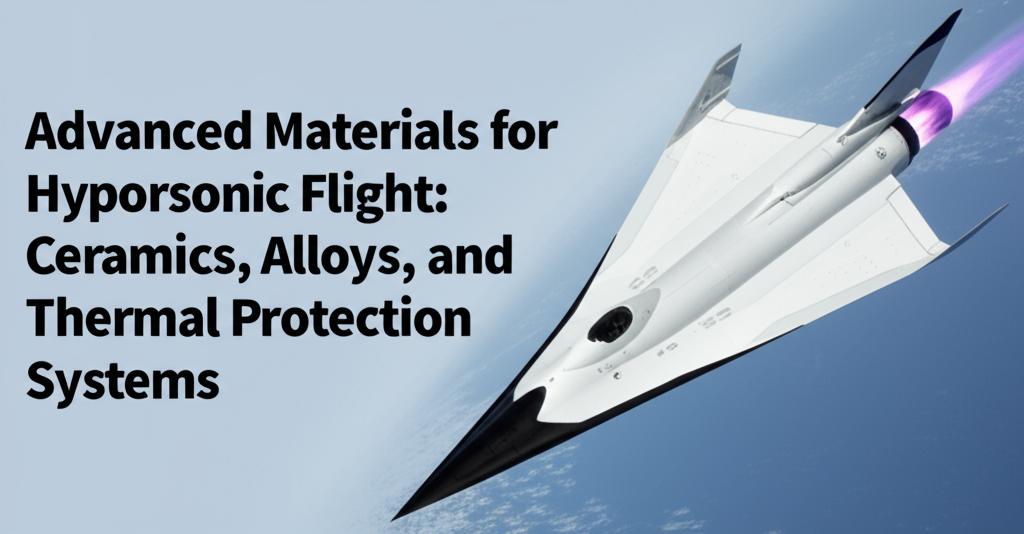Hypersonic flight, defined as exceeding five times the speed of sound (Mach 5), presents extreme material challenges due to intense aerodynamic heating, high mechanical loads, and rapid thermal cycling. Surface temperatures can surpass 1,600°C, and even reach over 3,000°C at stagnation points, demanding innovative material solutions.
Ceramics:Ultra-High Temperature Ceramics (UHTCs) are at the forefront of materials capable of withstanding the extreme conditions of hypersonic flight. These include materials like zirconium diboride (ZrB2), hafnium carbide (HfC), and titanium carbide (TiC). UHTCs offer exceptional thermal stability, withstanding temperatures above 3,000°C, making them suitable for leading edges, nose caps, and other high-stress components.
Recent advancements include:
- Ceramic Matrix Composites (CMCs): CMCs, such as those based on silicon carbide (SiC-SiC), offer enhanced thermal resistance and lower density compared to traditional nickel-based superalloys. They are reinforced with fibers or whiskers to improve strength. CMCs are being developed for primary aerostructures, thermal protection systems, and air-breathing propulsion components. Notable examples include C/ZrOC (carbon fiber/zirconium-oxide-carbide), which is low-cost, scalable, and shows promise for reusable heat shields.
- Additive Manufacturing of Ceramics: Researchers, for instance at Purdue Applied Research Institute (PARI), are developing new additive manufacturing techniques like Digital Light Processing (DLP) to 3D print "dark ceramics." These materials exhibit high resistance to extreme temperatures and are less prone to cracking. 3D printing allows for the creation of complex geometries with high precision, crucial for optimizing hypersonic vehicle performance. However, challenges remain in efficiently curing dark ceramics due to their light absorption properties.
- Carbide Coatings: Coating vehicle exteriors with ceramic carbides is a promising approach. Research teams from the University of Manchester and Central South University of China have developed a ceramic carbide material using Reactive Melt Infiltration (RMI) that is reportedly 12 times more durable than common UHTCs like ZrC.
Refractory metal alloys are critical for hypersonic applications due to their high melting points and ability to retain strength at elevated temperatures. These include alloys based on niobium (Nb), molybdenum (Mo), tungsten (W), and tantalum (Ta). They find use in components like reaction control system thrusters, wing leading edges, and propulsion systems.
Key developments include:
- Additive Manufacturing of Refractory Alloys: Additive manufacturing, particularly Laser Powder Bed Fusion (LPBF) and Laser Powder Directed Energy Deposition (LP-DED), is revolutionizing the fabrication of complex refractory alloy components. This allows for precise control over microstructure and properties, producing parts that can be lighter and stronger than those made with traditional methods. Initiatives like NASA's Refractory Alloy Additive Manufacturing Build Optimization (RAAMBO) project are advancing the readiness of AM refractory alloys for space and hypersonic applications, focusing on alloys like Niobium C103.
- High Entropy Alloys (HEAs): HEAs represent a newer class of materials being investigated for hypersonic applications. While research is still in its early stages and more data is needed, some HEAs show high potential for high-temperature strength and other desirable properties.
TPS are essential to shield hypersonic vehicles from extreme aerodynamic heating. Innovations in TPS focus on reusability, durability, and integrated functionalities.
Current areas of advancement include:
- Carbon-Carbon (C-C) Composites: C-C composites are lightweight and retain mechanical strength at extreme temperatures. They are used for thermal protection due to their thermal conductivity over a wide temperature range and can be implemented in aeroshells. However, oxidation at high temperatures remains a challenge, leading to research in protective coatings and matrix modifications (e.g., adding HfB2). Battelle is developing a selective laser heating system to carbonize C-C composites with greater precision and speed, aiming for more scalable and cost-effective production.
- Smart TPS: Companies like Canopy Aerospace are developing wireless "smart TPS" platforms. These systems integrate sensors for real-time structural health monitoring and aerothermal modeling, enhancing safety and providing critical data for future designs. This involves embedding wireless sensors into TPS materials to monitor their condition during flight.
- Integrated Passive and Active Cooling: The DARPA MACH (Materials Architectures and Characterization for Hypersonics) program is focused on developing integrated passive thermal management systems for leading edges, as well as exploring next-generation materials and active cooling concepts. This includes approaches like using highly conductive carbon-based fibers for passive cooling or ceramic sandwich TPS with ceramic foams for active cooling.
Despite significant progress, several challenges remain:
- Material Failure Mechanisms: Oxidation and microcracking due to thermal stresses are primary failure modes for hypersonic materials. Mitigating these issues is crucial for ensuring material lifespan and vehicle reusability.
- Manufacturing and Scalability: While additive manufacturing offers new possibilities, scaling up production of these advanced materials and components effectively and economically is an ongoing effort.
- Testing and Characterization: Accurately characterizing material behavior at the extreme temperatures and reactive flow environments encountered during hypersonic flight is complex. Facilities capable of replicating these conditions are vital for material development and validation.
Future research will continue to push towards materials with even higher temperature resistance, improved oxidation resistance, enhanced mechanical properties, and lighter weight. The convergence of advanced ceramics, novel alloys, sophisticated composite architectures, and innovative thermal management strategies will be key to unlocking the full potential of hypersonic flight.

